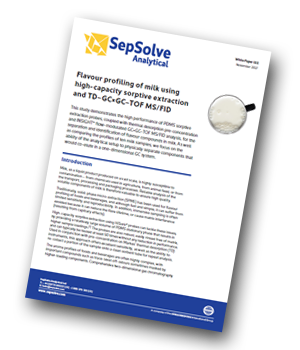SepSolve has produced a study demonstrating the separation and identification of flavour compounds in milk using high-capacity sorptive extraction and TD–GC×GC–TOF MS/FID. As well as comparing the profiles of ten milk samples, the focus is on the ability of the analytical setup to physically separate components that would co‑elute in a one‑dimensional GC system.
 Summary
Summary
Milk, as a liquid product produced on a vast scale, is highly susceptible to contamination – from chemicals used in agriculture, from animal feed, or from the transport, processing and packaging processes. Reliable analysis of the volatile components of milk is therefore valuable to ensure high quality.
Traditionally, solid-phase micro-extraction (SPME) has been used for flavour profiling of foods and beverages, and although fast and simple, it can suffer from limited sensitivity and reproducibility. In addition, immersive sampling is often avoided because it can reduce the fibre lifetime, or cause matrix interference (resulting from capillary effects).
High-capacity sorptive extraction using HiSorb™ probes can tackle these issues, by providing a relatively large volume of PDMS stationary phase that results in higher sample loadings. The probes are also robust, easily rinsed free of matrix, and can typically be reused at least 50 times without any reduction in performance.
Used in conjunction with pre-concentration on Markes’ thermal desorption (TD) instruments, this approach offers excellent sensitivity, as well as the ability to re‑collect a portion of the sample onto a clean sorbent tube for repeat analysis.
The aroma profiles of foods and beverages are often highly complex, with important compounds such as trace-level off-odours sometimes masked by higher-loading components. Comprehensive two‑dimensional gas chromatography (GC×GC) coupled with time-of-flight mass spectrometry (TOF MS) is therefore an excellent choice, with the enhanced separation capacity of GC×GC complementing the ability of (a) TOF MS to provide confident identification of targets and unknowns, and (b) FID to provide robust quantitative analyses. The GC×GC method employs INSIGHT™ reverse-fill/flush flow modulation, lowering running costs and avoiding the logistical issues associated with liquid cryogen.
Conclusions
The combination of high-capacity sorptive extraction with TD pre-concentration and INSIGHT™ GC×GC–TOF MS/FID analysis is a powerful approach to characterising the complex flavour profiles of milk
products, with minimal sample preparation.
As well as being easier to carry out than SPME, sampling with PDMS probes followed by TD pre-concentration offers improved sensitivity while retaining the ability to sample a wide range of chemical classes. The probes and tubes are also reusable, which minimises the cost per sample.
